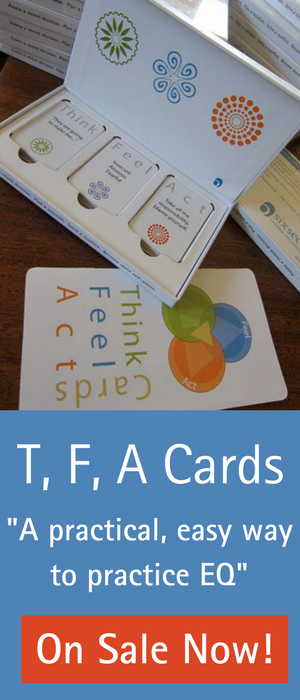Argh! What are they thinking?!?
Frustrated. Peeved. Annoyed. We’ve all been there. Conflicts and disagreements are simply a part of communities, a part of life. Even with people we love, we sometimes have disagreements and let tension simmer below the surface. But there are tools you can use to solve a conflict in a healthy and thorough manner. It starts with understanding that in any conflict or incident, both sides are making assumptions about what the other person is thinking, feeling, and doing – and these assumptions aren’t always accurate. To solve a conflict, you need to bring those assumptions into the open in a safe way. Think, Feel, Act cards are an awesome tool to help you or a client to do exactly that.
Check out these stories of turning conflict into understanding, and even, growth.
When two people aren’t seeing eye to eye in a conflict, it’s hard to know where to start. The beauty of T, F, A cards is that they break the situation down into smaller, more digestible parts – each person’s perceptions of the thoughts, feelings, and actions that are fueling the conflict. That way you can both see the other person’s perspective in a safe way (more on the safe part later), and start working together to solve a conflict. The cards are designed for open-ended experimentation, but here are a few examples (and a few more here) of how I have used them – with remarkable results. The first step is to identify each person’s perceptions of the situation.
This story is about a disagreement over money and decision making – specifically, what used car to buy – that escalated quickly. And how we got back to a place of sanity, understanding, and compassion. Have you ever had a simple thing like this get really out of hand?

… and I was a big fan. Having just checked it out with the owner, I came in the house excited and told my partner about it. She asked a few logistical questions, about cost and mileage, and right away I could tell she wasn’t a fan. As she talked about why not to buy it, I felt like her tone was condescending, and I felt hurt. I retreated into my normal pattern of evasion in the face of conflict, and I simply dropped the topic, but with tension clearly simmering right below the surface. It left us both uncomfortable, divided over something silly. We left it alone at that moment and moved on, but we came back to the topic that evening. She started by saying genuinely that she didn’t mean to hurt my feelings with her reaction – and we decided to use T, F, A cards to break down what went wrong, and how we can both respond differently the next time. The first step was to identify each of our perceptions of the other one’s thoughts, feelings, and actions.
The first cards are the ones I chose about how she was thinking, feeling and acting. The second set are the cards she chose about me. But the rule that makes this exercise helpful, instead of fueling the fire, is the following: As each person shares, the other is not allowed to interrupt or disagree. These are each person’s perceptions, and each person will have an opportunity to make observations soon.
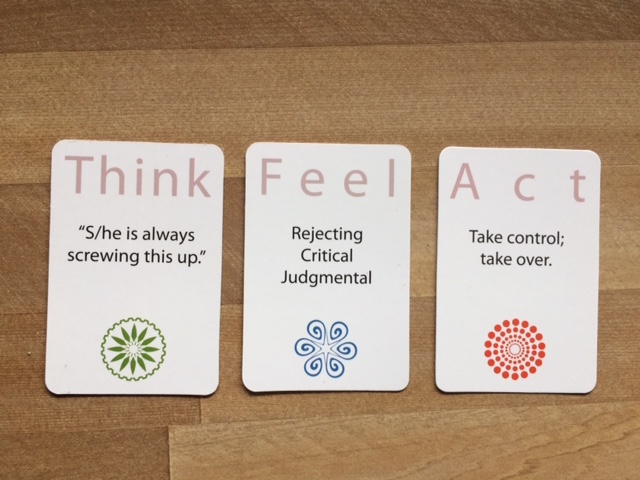
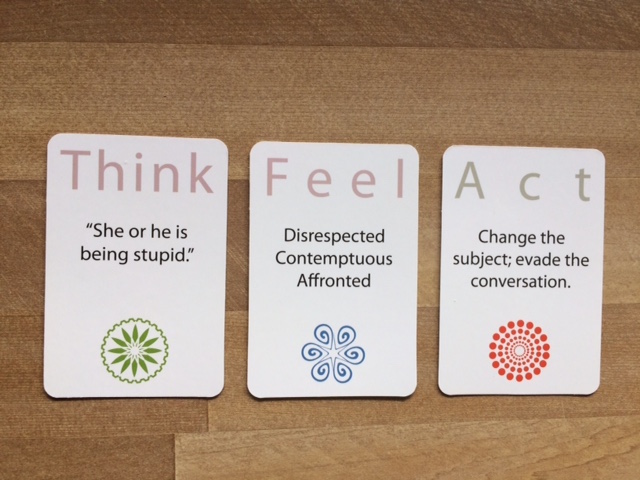
Me: My perceptions were that you thought that I was screwing up this car purchase, felt critical and judgmental, and had started the process of taking control and doing it yourself.
Her: My perceptions were that you felt disrespected, thought that my opinion was stupid, and changed the subject to evade the argument.
Then we discussed. And an amazing thing happened. Simply having to share the assumptions we were making helped us both see that we had misinterpreted – or at least exaggerated – the other person’s thoughts, feelings, and actions. She said, “I wasn’t meaning to take over. I really wanted to provide a perspective you may not have considered yet…” and “I did not want to give the impression that you were screwing it up…” And on my side, I acknowledged that I felt affronted because I was really excited and her initial reaction was negative, and apologized for changing the subject instead of talking about it.
Seeing it laid out on the table and discussing it was clarifying all by itself. But the best part is when we got to choose new cards, based on the thoughts, feelings, and actions we would wish for from the other person. Here are our new wishes for each other:
Once again, the cards I chose are on the left, and those represent what I would wish for her to be thinking, feeling, and doing. Her cards are on the right.
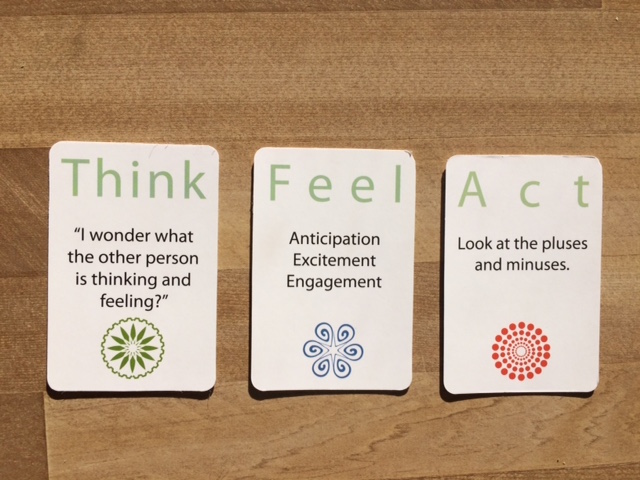
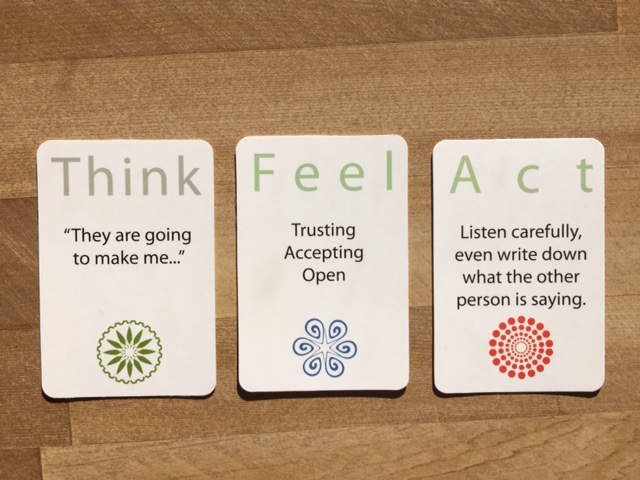
She noticed right away that the feelings I wanted from her were excitement and engagement.
I came in excited, and even if she had concerns, meeting my excitement with some sort of validation first would have put us more on the same team. Then maybe we would both be more open to the other person’s thoughts and feelings, and we could look at the pluses and minuses together.
I noticed right away that she wanted me to feel trusting of her and open to her advice.
As soon as she was critical, I got defensive. And she wished for me to think that she was trying to help me and any advice was given from a place of love. I thought the action she chose was interesting, “Listen carefully, and write down what the other person is saying.” And she was definitely right, when I felt judged and became defensive, my listening ability went out the window. Maybe writing down her concerns on the “cons” side of a pros cons list would have helped me feel less personally attacked.
Isn’t that a cool way to practice empathy and move forward together?
And another cool thing is, you can go through this process even if the other person isn’t ready to pull out the T, F, A cards. As this next story shows, you can have yourself or a client choose cards for themselves and for the other person in a conflict. It’s still an amazing exercise in perspective taking that can open the doors to solve a conflict.
This story is about work, expectations, and of course, unspoken assumptions.
Thoughts, Feelings, and Actions: In What Order?
Our thoughts, feelings, and actions rarely occur in a neat, linear fashion. There’s a dynamic interplay between them, and they can all be a catalyst for the other two. For example, it’s commonly recognized that our thoughts affect feelings. If you think about your best friend moving away, you feel sad. Or if you think about that guy who was super rude to you, you feel angry. What’s often less understood is that our feelings also affect our thoughts. If you are afraid, you may look for and notice more threats. If you’re stressed or anxious, you will think an irritant is worse than you would if you were feeling happy. Similarly, even actions affect thoughts and feelings. Just smiling, or taking a deep breath, calms our body and mind, changing how we think and feel. People often confuse thoughts and feelings. An easy test is that if you catch yourself saying “like” or “as if”, like when we say “I feel like you weren’t listening,” that is actually a thought, not a feeling. It’s an evaluative observation. The feeling behind it may be something like, “I feel ignored.” T, F, A cards help you see the difference between these 3 and the relationships between them.

You may also like, Want a Hands-On Tool to Practice EQ? Try T, F, A Cards.
Here’s another story about a time my boss and I were not on the same page – and when I dove deeper into it, I realized that I had more options than I thought.

… and I didn’t feel like my boss was supporting me. A coach led me through this exercise with T, F, A cards on how to solve a conflict by learning to see my patterns and the options that I really had. We started off by identifying my thoughts, feelings and actions in relation to my work, and my perceptions of my boss’ thoughts, feelings and actions. Once again, I used T, F, A cards to break down a big, complex situation into more manageable parts. Here are the cards, for my own T, F, A on the left, and my boss’ on the right:


I felt helpless, victimized. And that led me to wanting to give up, not only on myself and my boss but on the organization itself.
As far as I could tell, my boss was frustrated by the work left undone, thought I wasn’t doing enough, and was determined to push on regardless of how I felt.
The next step was look at the T, F, A cards and choose the cards that represent what I would like to have happen, both from myself and from my boss. Once again, the cards on the left are what I chose for myself, and the cards on the right I chose for how I want my boss to feel.


I started off by thinking, “What are some other ways to see this?” And the action card I chose is to identify and evaluate 3 different options. So I made a short list of new ways to look at my ever growing pile of work.
- They send all this work my way because they trust me to do it well.
- My boss is frustrated by the pace of work in general, but it is not necessarily personal.
- I could be more honest about how the work I have to do compares with the time I have to do it all.
Evaluating these 3 different options really made me question some of my assumptions. First of all, simply thinking that my mountain of work was the result of my ability to get it done made it seem like less of a burden, and kind of an honor. I started to feel new inklings of excitement about my work. Then when I looked at the second and third option, I really started to question if my assumptions about my boss’ thoughts, feeling and actions were even very accurate.
I wanted my boss to think, “What does this person really need?” But had I even been honest with her about my feelings? Does she really know how overwhelmed I feel? And then it it hit me. How could I expect her to be attuned to my needs if I wasn’t honest about them? I want her to be happy and pleased with my work, but a good first step would be to ask her how she felt about my work. I got this sense of general frustration, but it’s very possible that I had over personalized it. I want her to listen carefully to my thoughts and feelings, but communication is most definitely a two-way street. For her to listen, I had to be willing to speak up candidly and compassionately.
This exercise transformed my T, F, A from helplessness to a renewed sense of hope and power. The T, F, A cards helped me see that I had more options than I had realized and that I needed to get more clarity. To solve a conflict, it’s essential to address the assumptions we make about ourselves and the other person, and to challenge those. The cards helped me activate 3 vital skills of emotional intelligence:

Increase Empathy
The cards helped me put myself in my boss’ shoes, and even realize that I was making assumptions about her that I needed to check for accuracy. The whole process deepened and strengthened our relationship. Learn more about Increasing Empathy.

Exercise Optimism
The cards helped me see that I had more options than I thought I had. I was sort of assuming unconsciously that wallowing in my helplessness was my only option, and it wasn’t. When you are feeling stuck, this is a lifeline. Learn more about Exercise Optimism.

Navigate Emotions
This entire process was what Six Seconds refers to as Navigating Emotions. Assessing, harnessing and transforming emotions as a strategic resource. My feelings helped me see more clearly and act more deliberately. Learn more about Navigating Emotions.
Bite Sized Is Better
For me, the power of T, F, A cards is that it breaks down the situation so wonderfully into manageable parts. I so often feel overwhelmed, especially in complex situations, by all of my various thoughts, feelings and actions. So to break them down is essential.
And there are two cool tricks that I didn’t go over in the examples above:
Blank T, F, A Cards – The packet comes with two cards that are blank for each category, so you can write in your own Thought, Feeling, or Action.
Choose More Than One – You can choose more than one card per category. In fact, feelings are complex and we will often feel different feelings, or have taken multiple actions, in relation to a situation.
If you want to buy your own set of T, F, A cards, you can get them in the EQ Store by clicking on this link. They’re on sale for $18.95.
- Pursue Noble Goals in the Six Seconds Model of EQ - July 29, 2023
- Increase Empathy in the Six Seconds Model of EQ - July 26, 2023
- Exercise Optimism - July 24, 2023

